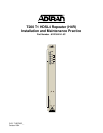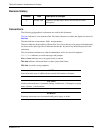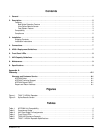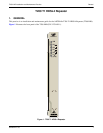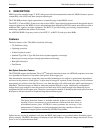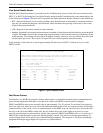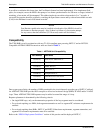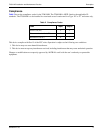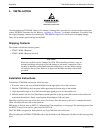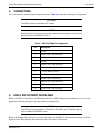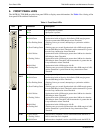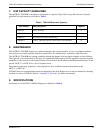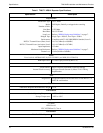
T200 H4R Installation and Maintenance Practice Description
61223441L1-5C 3
View Splice Results Screen
The Bad Splice Detection feature is accessed from the Troubleshooting screen via the craft access terminal of the
H4TU-C or H4TU-R. Selecting the View Splice Results option from the Troubleshooting screen menu displays the
screen illustrated in Figure 2. Results will be reported in the Splice Detection Results column for each transceiver:
• NTF - Reported if the unit is active and no problems have been detected or the number of anomalies detected
have not yet reached the detection count threshold, which facilitates the reporting of the result to this screen.
(Eight is the present threshold.)
• LOS - Reported if the remote unit has not been detected.
• Number - Reported if an anomaly has been detected a number of times that exceeds the detection count threshold
of eight. The number shown in this column represents the number of feet from the transceiver (Reference Point)
to that anomaly. This number will also reflect the highest anomaly count seen, as it is possible to have more than
one bad splice per circuit. This screen will report the worst (most frequently detected) anomaly.
In this example, a detection has occurred approximately 650 feet from an H4TU-C module on Loop 2 of the
HDSL4 circuit.
Figure 2. Splice Results Screen
Fast Retrain Feature
Fast Retrain is an ADTRAN proprietary feature whose intent is to minimize downtime when an intermittent non
power-related impairment (bad splice, noise burst, etc.) affects the HDSL loop and cannot be bridged.
HDSL2 and HDSL4 transceivers normally train in approximately 25 to 30 seconds. For an initial circuit turn-up,
this is not a big issue. However, once service has been established on the circuit, any large down-time will interrupt
communications on the circuit. A loss of synchronization on the HDSL loop can cause excessive down times due
not only to the 30-second HDSL retrain time, but also further delays due to the higher level protocols in the
network going through re-synchronization. On the older generation HDSL2 and HDSL4 units, a 1-second loss of
HDSL frame synchronization would cause the data pumps to retrain. This retrain would take approximately 25
seconds during which AIS would be sent to the terminating equipment. The reception of AIS by the terminating
equipment then might trigger higher level protocol re-synchronizations.
Circuit ID:HTSVALHDSL4 06/17/04 07:32:04
Press ESC to return to previous menu
* Note: Chronic Circuit Results are only valid after all other circuit *
* qualification tests have been performed and failed to show a trouble !! *
Splice Detector Version 1 Result Definitions:
---------------------------------------------
NTF - No Trouble Found yet.
LOS - Unit not in sync.
Number - Distance from Reference point (in ft.) of suspect splice.
Reference Splice Detection Results Version Result Shown
Point Loop 1 Loop 2 Number for date
--------- ---------- ---------- ------- MM/DD/YY
H4TUC NTF 650 01 --------
H4TUR NTF NTF 01 06/17/04
H4RU1 NET NTF NTF 01
H4RU1 CST NTF NTF 01 (B)Back



